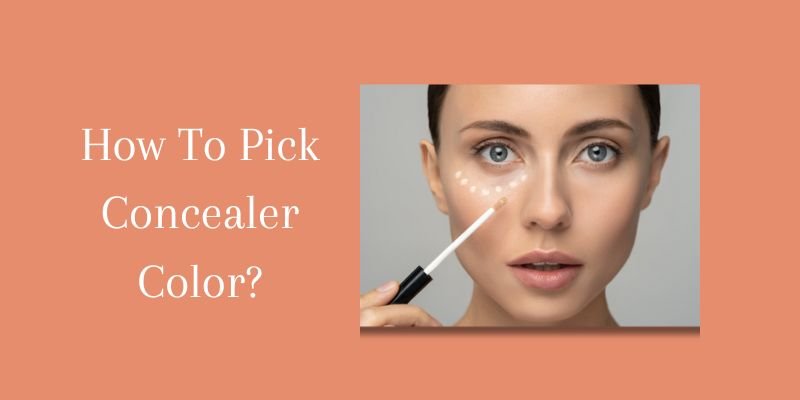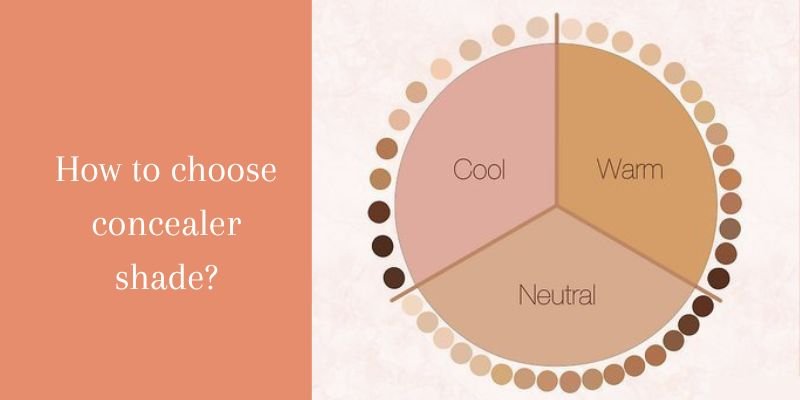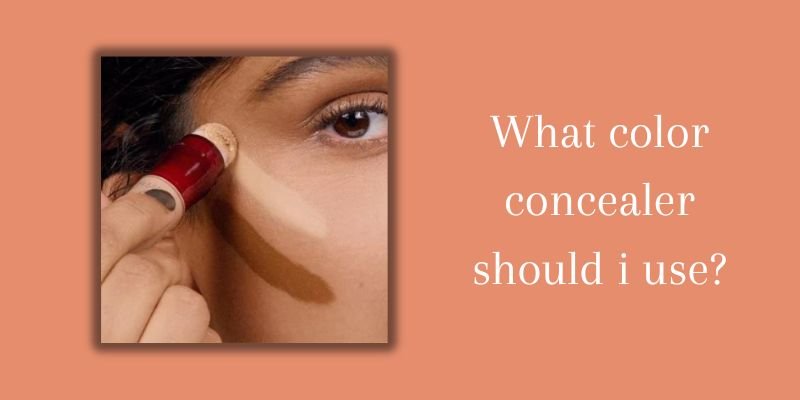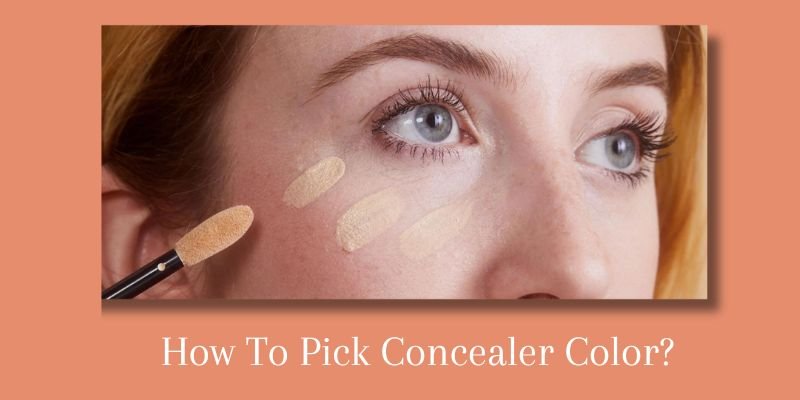Choosing the right concealer color can feel like navigating a maze of endless shades and undertones. Whether you’re trying to hide dark circles, blemishes, or simply brighten up your complexion, finding the perfect match for your skin can be a game-changer in your beauty routine.
Learn the methods for perfect coverage and seamless blending with our in-depth advice on How To Pick Concealer Color. Finding your undertones and mastering color correction techniques are made simple with our step-by-step instructions, which guarantee a perfect complexion every time.
How To Pick Concealer Color?
It’s important to take your skin tone and the concealer’s intended use into account when selecting the appropriate shade of concealer. For covering dark circles or blemishes, opt for a shade that is slightly lighter than your natural skin tone to brighten and correct imperfections.
If you’re looking to contour or highlight, choose a concealer that is two shades lighter than your foundation for a more sculpted look. Don’t forget to test the concealer on your jawline before purchasing to ensure it blends seamlessly with your skin.

Understanding color theory can help in selecting the perfect concealer shade. For neutralizing redness or acne scars, use a green-toned concealer; for counteracting darkness under the eyes, opt for peach or orange tones; and for highlighting areas like cheekbones, use a lighter shade with pink or yellow undertones.
To select the perfect concealer hue that complements your particular complexion and desired cosmetic style, keep in mind that experimentation is essential.
Matching Concealer to Undertone
Achieving a perfect look when choosing concealer requires matching your undertone to the hue you choose. Finding the ideal hue that complements your skin tone can be greatly aided by knowing whether you have a warm, cool, or neutral undertone.
If you have a warm undertone, opt for concealers with peachy or yellow tones to counteract any redness or dark circles. For those with cooler undertones, look for concealers with pink or blue hues to brighten and correct any discoloration.

It’s important not to overlook your undertone when selecting a concealer color as it can drastically impact how well it blends with your natural skin tone. Choosing a concealer that matches your undertone can help create a seamless finish and prevent the dreaded cakey look.
Experimenting with different shades based on your undertone can lead to discovering new favorites that enhance your complexion and boost your confidence. By taking into account your undertone when picking out concealers, you can ensure a more polished and polished makeup application every time.
Concealer Shades for Contouring
Understanding the nuances of concealer shades for contouring is crucial for achieving a flawless makeup look. The interplay between light and dark tones allows you to sculpt your face like a work of art, enhancing your natural features.
By strategically placing the lighter shade on high points and the darker shade in recessed areas, you can create depth and dimension that adds drama to your overall appearance. Blending is key in ensuring that transitions between shades are seamless, giving you a professionally sculpted finish that enhances your facial structure.
Choosing the right concealer shades is akin to being an artist with a palette, allowing you to create optical illusions and highlight your best features. Experimenting with different tones can help you understand how subtle changes in shading can completely transform your face shape.
The contrast achieved by using two shades lighter and one shade darker than your foundation color adds depth and vitality to your complexion, accentuating what nature has already provided.

Embrace the transformative power of makeup as a tool for self-expression, allowing you to play with light and shadow to reveal different facets of your beauty.
As trends evolve and new techniques emerge, mastering the art of contouring with concealer shades opens up endless possibilities for enhancing your facial contours. Combine creativity with skillful application techniques to unlock hidden dimensions within your face, providing a canvas for experimentation and self-discovery through makeup.
Embrace the challenge of sculpting shadows and highlights with precision, knowing that each stroke contributes to an aesthetic masterpiece that uniquely reflects your personality and style preferences.
Consider coverage and consistency
Coverage refers to how well the concealer can hide imperfections and dark circles, while consistency relates to the texture of the product. Opting for a high-coverage concealer can be a game-changer for those dealing with stubborn blemishes or pigmentation issues. A lightweight and buildable formula may be more suitable for everyday use or for achieving a natural look.
Matching the concealer color to your skin tone is crucial for seamless blending and achieving a flawless finish. Experimenting with different shades can help you determine the best match for your complexion, taking into account factors such as undertones and any discoloration you wish to conceal.
Keep in mind that your ideal concealer shade may vary depending on whether you’re aiming to brighten under-eye areas or cover blemishes on other parts of your face. By prioritizing both coverage and consistency in your selection process, you can ensure that your chosen concealer effectively meets your specific needs while enhancing your overall makeup routine.
Match to specific concerns (dark circles, blemishes)
Understanding your skin tone is essential when selecting the ideal concealer color for particular skin issues like dark circles and pimples. For dark circles, opting for a concealer with a peach or salmon undertone can help counteract the blue or purple hues.
This can brighten the under-eye area and create a more even complexion. When dealing with blemishes, look for a concealer that matches your skin tone as closely as possible to effectively cover any imperfections without drawing attention to them.
It’s important to remember that different parts of your face may require different shades of concealer. For example, you may need a slightly lighter shade for under-eye circles and a matching shade for blemishes in order to achieve seamless coverage. Experimenting with various tones can help you find the ideal concealer color that addresses each specific concern while blending seamlessly into your natural skin tone.
By selecting concealers tailored to your individual needs, you can achieve flawless-looking skin that enhances your overall complexion and boosts confidence.
While Choosing the right shade, consider the formulation of the concealer to ensure it suits your concerns. Opt for creamy textures for dry areas or liquid formulas for easy blending on larger surface areas. Understanding how different formulas work on various concerns allows you to customize your makeup routine effectively based on what works best for each unique need.
Picking the perfect concealer color requires taking into account not only your skin tone but also the specific concerns you are targeting leading to a flawless finish that enhances rather than masks your natural beauty.
Try on different shades in natural light
When selecting a concealer shade, it’s crucial to try different options in natural light. Natural light provides the most accurate reflection of how the shade will appear on your skin throughout the day. Experimenting with different shades in natural light allows you to observe how they blend seamlessly with your complexion, ensuring a flawless finish that matches your true skin tone.
Changing lighting conditions can alter how a concealer color appears on your skin. By trying on different shades in various natural lighting settings, you can determine which one complements your features best under different circumstances. This practice helps you choose a versatile shade that will adapt to different environments and occasions, ensuring you always look radiant and well-rested no matter where you go.
The key to finding the perfect concealer color is not just about matching it to your skin tone but also considering factors like undertones and natural lighting variations. Embrace the process of experimentation and be open to trying out new shades in different lighting scenarios for a customized beauty solution that enhances your unique features effortlessly.
How To Apply Concealer
When applying concealer, it’s essential to choose the right shade that matches your skin tone to achieve a seamless and natural look. Start by selecting a creamy formula that offers good coverage without feeling heavy on the skin. Using a small brush or your fingertips, gently dab the concealer onto areas with blemishes or dark circles, then blend it in using quick tapping motions. Remember to apply only a thin layer of product to avoid creasing or caking.
To create a flawless finish, consider using a color corrector before applying concealer to neutralize any discoloration on the skin. For under-eye circles, use a peach or salmon-toned corrector before adding concealer for better coverage. Setting your concealer with a translucent powder can help lock it in place and prevent smudging throughout the day. By following these steps and techniques, you can effortlessly achieve an even complexion and enhance your natural beauty with the perfect application of concealer.
Conclusion
Selecting the right concealer color is an essential step in achieving a flawless makeup look. By understanding your skin tone, undertone, and specific concerns, you can confidently choose a concealer that will effectively camouflage imperfections and brighten your complexion.
Experimenting with different shades and formulas can help you find the perfect match for your unique needs. Remember to test the concealer in natural light before making a final decision, as this can ensure the most accurate color selection. With these straightforward tips at your disposal, you’ll have ability to decide How To Pick Concealer Color.
FAQs
How to choose a concealer palette?
There are three main types of skin undertones, namely, warm, cool, and neutral. If you have warm undertones, then you should pick concealer with a gold or yellow shade. Cool undertones match concealer with pink and bluish hues. And neutral undertones can often enjoy the best of both worlds!
What color concealer for dark circles?
When it comes to correcting pesky under-eye circles, think sunny colors. According to Quinn Murphy, a celebrity makeup artist and host of In My Chair podcast, the best way to counter dark circles is to apply some variation of orange.
Which concealer shade is best for fair skin?
Color corrector concealers come in three shades: light, peach/salmon, and green. Light correctors brighten fair to light skin tones, peach/salmon correctors tackle dark circles, and green correctors neutralize redness and blemishes.
You may also like:

